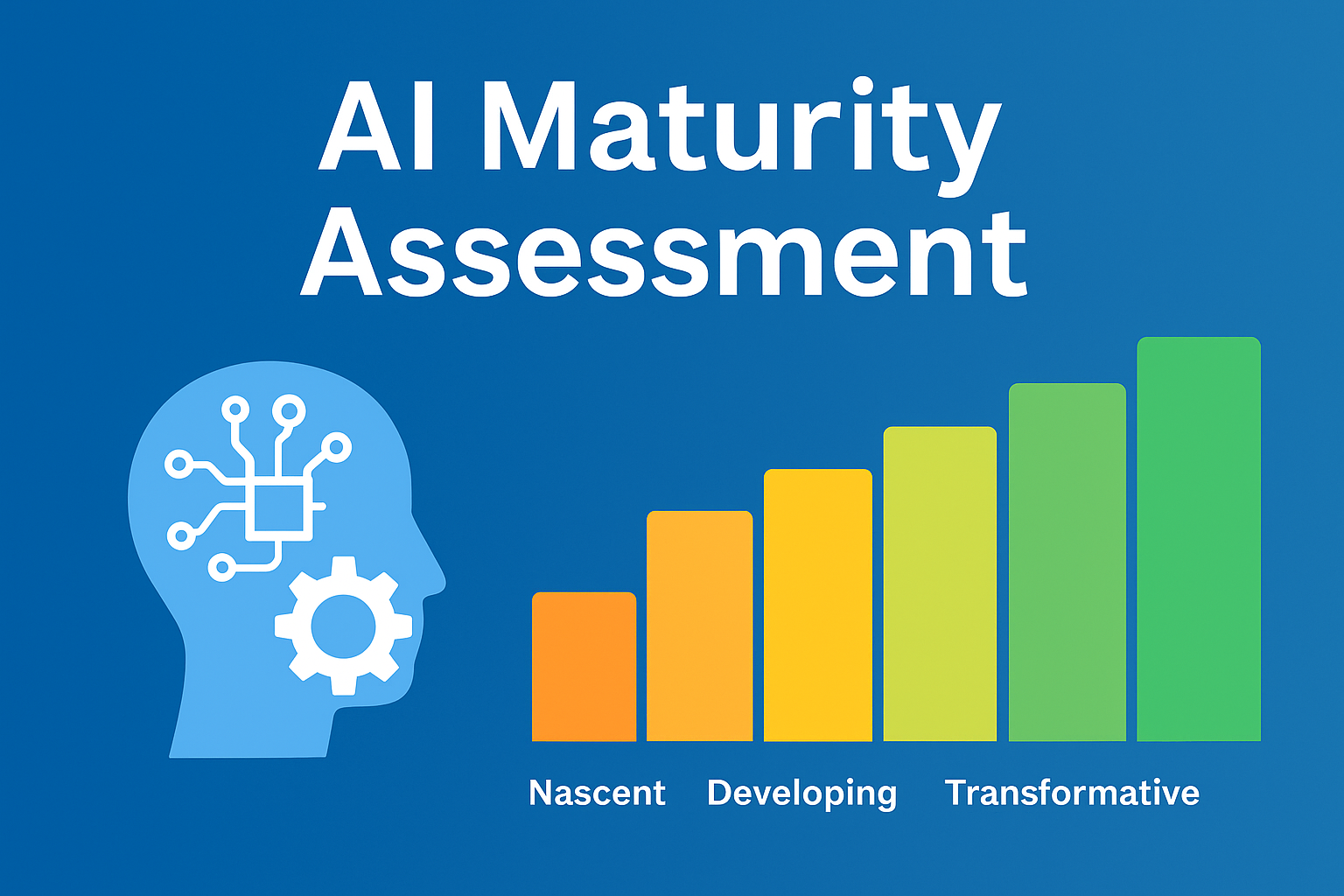Introduction
In an age where artificial intelligence (AI) is no longer a futuristic concept but a core competitive asset, organizations often rush into AI projects without understanding their actual preparedness. According to recent studies, while ~78% of companies are using AI in some capacity, nearly 74% aren’t seeing real value from their investments. To bridge this gap, it’s essential to assess your organization’s AI maturity level—to discover where you stand, uncover gaps, and lay out a roadmap to move forward.
In this post, we will explore key frameworks for AI maturity assessment, walk through implementation strategies, and offer actionable steps based on different maturity levels.
What Does It Mean to Be ‘Mature’ in AI?
“AI maturity” is about more than having powerful models or large datasets. It’s about integrating AI across several dimensions—data, technology, people & culture, processes, governance & ethics—so that AI is embedded into the organization’s way of working, driving measurable value.
Key Pillars of Enterprise AI Maturity
To evaluate AI maturity effectively, focus on these five foundational pillars:
| Pillar | What to Check |
|---|---|
| Data | Is data clean, accessible, well governed? Do you have reliable data pipelines and appropriate data quality controls? |
| Technology & Infrastructure | Do you have scalable AI / ML tools, MLOps practices, cloud or on-prem infrastructure ready for production scale? |
| People & Culture | Is there AI literacy across teams? Is leadership committed? Are there roles and skills aligned with AI initiatives? |
| Processes | How are AI models and projects integrated into workflow and decision-making? Are there well-defined processes (e.g. model deployment, maintenance, feedback loops)? |
| Governance & Ethics | Are there policies for responsible AI use—bias, explainability, accountability, risk management? Are compliance, legal, and ethical practices built in? |
Five AI Maturity Stages
Understanding maturity stages helps benchmark where you are, and what the next steps should be:
- Nascent / Experimenter – Initial experiments; ad-hoc projects; no central strategy.
- Developing / Builder – Multiple AI pilots; silos; some successes but disjointed.
- Mature / Operator – Central strategy in place; AI in key functions; CoE or equivalent structure; governance starts solidifying.
- Transformative / Leader – AI is core competitive lever; frequent innovation; culture aligned; business model being extended/enhanced by AI.
- Leading / Visionary – Organization not just using AI but shaping industry norms; designing new paradigms; pushing ethical, regulatory, and technological frontiers.
Business Benefits of Assessing AI Maturity
Conducting an AI maturity assessment brings several concrete advantages:
- A clear view of current capabilities — what works and what doesn’t
- Ability to identify critical gaps and bottlenecks (e.g. in data, skills, tech)
- Prioritize investments with maximum ROI
- Align AI initiatives with strategic business goals
- Benchmark against peers / competitors
- Better resource planning and risk reduction
Key Frameworks to Use
Some established frameworks that many organizations rely on:
- Gartner’s AI Maturity Model
- Deloitte’s AI Maturity Framework
- Forrester’s AI Readiness Model
- MIT CISR’s Enterprise AI Maturity Model
- ServiceNow-Oxford Economics’ AI Maturity Index
These provide structure, common language, and benchmarks. However, they often need customization to reflect your industry context, scale, culture, and goals.
DIY / Custom Self-Assessment Framework
If you want to adapt your own assessment, focus on asking strategic questions in these quadrants:
- Data: How reliable is your data? Is governance clear?
- Tech & Infrastructure: Can your systems handle scaling (many models, production workloads)? Are tools well integrated?
- Culture & Talent: Do people know what AI can and cannot do? Is leadership supportive? Is there cross-department coordination?
- Governance & Ethics: Who is accountable? How do you ensure fairness, explainability, privacy?
From Theory to Action: 4-Step Implementation Roadmap
To turn insights into action, follow a structured roadmap:
- Benchmark Your Current State – gather data via surveys, workshops, technical audits. Get input across departments.
- Identify Capability Gaps – data issues, skill shortages, tech limitations, weak governance.
- Align AI with Business Strategy – every AI initiative should map to a business objective (cost saving, revenue growth, customer experience, risk mitigation).
- Build a Phased Action Plan – prioritize based on impact vs complexity; plan for short wins and long-term foundational work; assign owners; set KPIs.
Implementation: What to Do at Each Stage
Here are suggested actions depending on your current maturity level:
- Levels 1-2 (Experimenters / Builders)
Pilot small projects that demonstrate value
Begin cleaning / organizing data
Invest in basic AI literacy / training - Level 3 (Operator)
Set up a Centre of Excellence or AI leadership group
Implement formal governance and policies
Adopt tools and infrastructure to scale AI reliably - Levels 4-5 (Leaders / Visionaries)
Push innovation, explore cutting-edge AI (e.g. generative AI, reinforcement learning, autonomous agents)
Embed AI in business models, products, and services
Lead in ethics, regulation, external collaboration
Common Pitfalls & How to Avoid Them
- Overestimating Maturity — assuming success in one area (tech or AI pilots) means readiness in all areas
- Neglecting Cultural Readiness — people resist change; lack of skills and mindset can stall adoption
- Underfunding Governance & Ethics — risk is high without transparency, fairness, legal compliance
- Skipping Change Management — deploying models is useless if users don’t adopt them; internal alignment matters
Future-Proofing Your AI Strategy
AI is evolving rapidly. To stay ahead:
- Keep the maturity assessment dynamic—review and update regularly
- Watch new AI paradigms (generative AI, autonomous agents, quantum, etc.)
- Maintain flexibility—business goals and technological landscapes change
- Build feedback loops—monitor performance, gather user input, adapt
Conclusion
An AI maturity assessment isn’t a “nice-to-have”—it’s critical for realizing real value from AI. By understanding where you really are, what gaps exist, and how to move forward, organizations can avoid wasted investments and set themselves up to be leaders rather than laggards.
Start with honest assessment, align AI efforts with business strategy, and build incrementally. Over time, you’ll climb the maturity curve—not just using AI, but mastering it.



